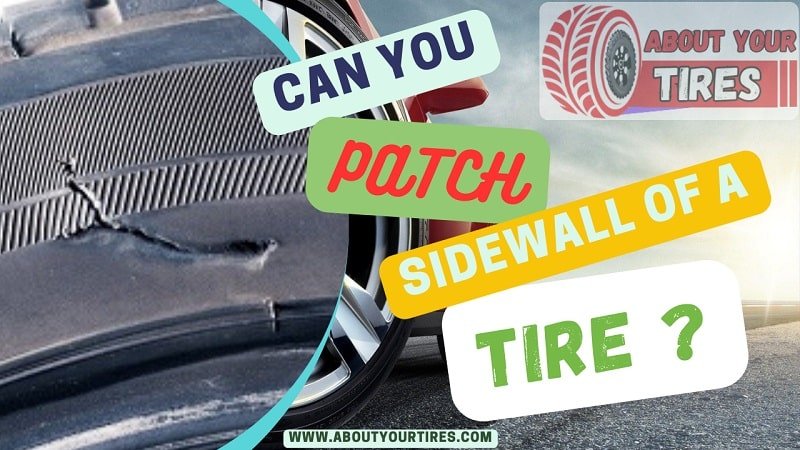Can You Patch The Sidewall Of A Tire?, Tires are the unsung heroes of our daily commute, bearing the brunt of potholes, sharp debris, and even the occasional curb nudge. While flat tires are common, they’re typically caused by punctures in the tread area that can be patched up relatively easily.
But what if the damage is on the tire’s sidewall, that seemingly vulnerable spot? Can you patch the sidewall of a tire? In this article, we’ll embark on a rubbery adventure to explore the possibilities, uncover some technical details, and hopefully sprinkle a dash of humor along the way.
The Anatomy of a Tire
Before we dive into the sidewall conundrum, let’s get acquainted with the basic structure of a tire. Imagine a tire as a delicious layered cake; there’s more to it than meets the eye:
1. Tread: The top layer of the tire that meets the road, featuring grooves and patterns for traction.
2. Sidewall: The vertical side of the tire, connecting the tread to the inner structure, often adorned with manufacturer branding.
3. Bead: The tire’s innermost edge, in contact with the wheel’s rim, ensuring a snug fit.
4. Carcass: The internal framework, made of layers of fabric and steel cords, providing the tire’s shape and strength.
Now that we understand the tire’s layers, let’s focus on the tricky sidewall.
Why Sidewalls Are Special
The sidewall might seem like just another part of the tire, but it has a special role to play in maintaining structural integrity and safety. It’s the tire’s unsung hero, a guardian of its shape and strength. But here’s the kicker – sidewalls are more prone to damage than the tough-tread region due to their thin, flexible nature.
1. Vulnerability: Sidewalls are exposed and often have less protection compared to the tread, making them susceptible to punctures, cuts, and scrapes.
2. Flexibility: The sidewall’s flexibility allows the tire to conform to the road surface, providing a smoother ride, but it also makes it less resistant to damage.
So, can we patch these flexible, vulnerable sidewalls? Let’s find out.
The Golden Rule – No Patching for Sidewalls

To patch or not to patch? That’s the million-dollar question. Well, folks, the golden rule in the tire world is this: NEVER patch a sidewall. Seriously, don’t even think about it. Why? Here’s the scoop:
1. Safety First: Sidewall patches compromise your safety. They can’t provide the same structural integrity as a proper tire.
2. Tread Patches Only: Patching a tire’s sidewall is like trying to put a Band-Aid on a broken bone – it just won’t cut it.
Now, you might be wondering why sidewall patches are a no-go. It’s all about maintaining the structural integrity of your tire. The sidewall is crucial for that, and any patching attempt here is a recipe for disaster.
When to Say Goodbye
As much as we might hate to admit it, there are times when a tire simply can’t be saved. Sidewall damage falls into this category. So, when should you bid adieu to your tire?
1. Deep Cuts: If the damage to your sidewall is more than just a surface scrape, it’s time to let go. Deep cuts can compromise the tire’s internal structure.
2. Exposed Cords: If you can see the steel cords inside the sidewall, that’s a bad sign. The cords are like the tire’s backbone, and if they’re visible, it’s a one-way ticket to tire heaven.
3. Bulging Sidewall: A bulging sidewall is a sign of internal damage. It’s like a tire’s version of indigestion, and there’s no easy fix for that.
Tire Maintenance Tips
So, we’ve established that sidewall patching is a no-no, but that doesn’t mean we should neglect our tires. Proper maintenance is key to preventing sidewall damage in the first place. Here are some tips:
1. Inflation Matters: Maintain proper tire pressure. Over-inflated or under-inflated tires are more prone to damage, including the sidewall.
2. Avoid Curbs: Be gentle with those curbs. Hitting them too hard can cause sidewall damage. Remember, they’re not going to apologize for messing up your tire.
3. Regular Inspections: Keep an eye on your tires for any signs of damage. Catching issues early can prevent them from getting worse.
Choosing the Right Replacement
When it’s time to replace a damaged tire, it’s essential to choose the right one. Here are a few things to consider:
1. Match the Tread: Try to match the new tire’s tread pattern and depth with the existing tires. This ensures even wear and better handling.
2. Check the Size: Make sure the new tire is the correct size for your vehicle. Consult your owner’s manual or the sidewall of your existing tires for guidance.
3. Brand and Quality: Invest in a reputable tire brand, as it can impact the tire’s performance, safety, and durability.
Tire Jokes – Because We All Need a Laugh
Alright, let’s take a moment to enjoy some tire-related humor, shall we?
1. Why did the tire go to the gym? To get a little more “tread” mill time!
2. What do you call a tire that’s been out in the sun for too long? A flat tire!
3. Did you hear about the tire who won the race? It was rolling in the fast lane!
Remember, a good laugh is the best remedy for those tire troubles.
Conclusion
In the world of tires, the sidewall is like the unsung hero – quietly doing its job, but oh so important. While we’ve learned that patching the sidewall is a big no-no, the good news is that proper maintenance and timely replacement can keep your tires rolling safely down the road. So, the next time you encounter sidewall damage, remember the golden rule – it’s time to retire that tire. And as you do, share a tire joke or two with your fellow drivers to keep the spirit of humor alive on the highway! Safe travels, my rubbery companions.

